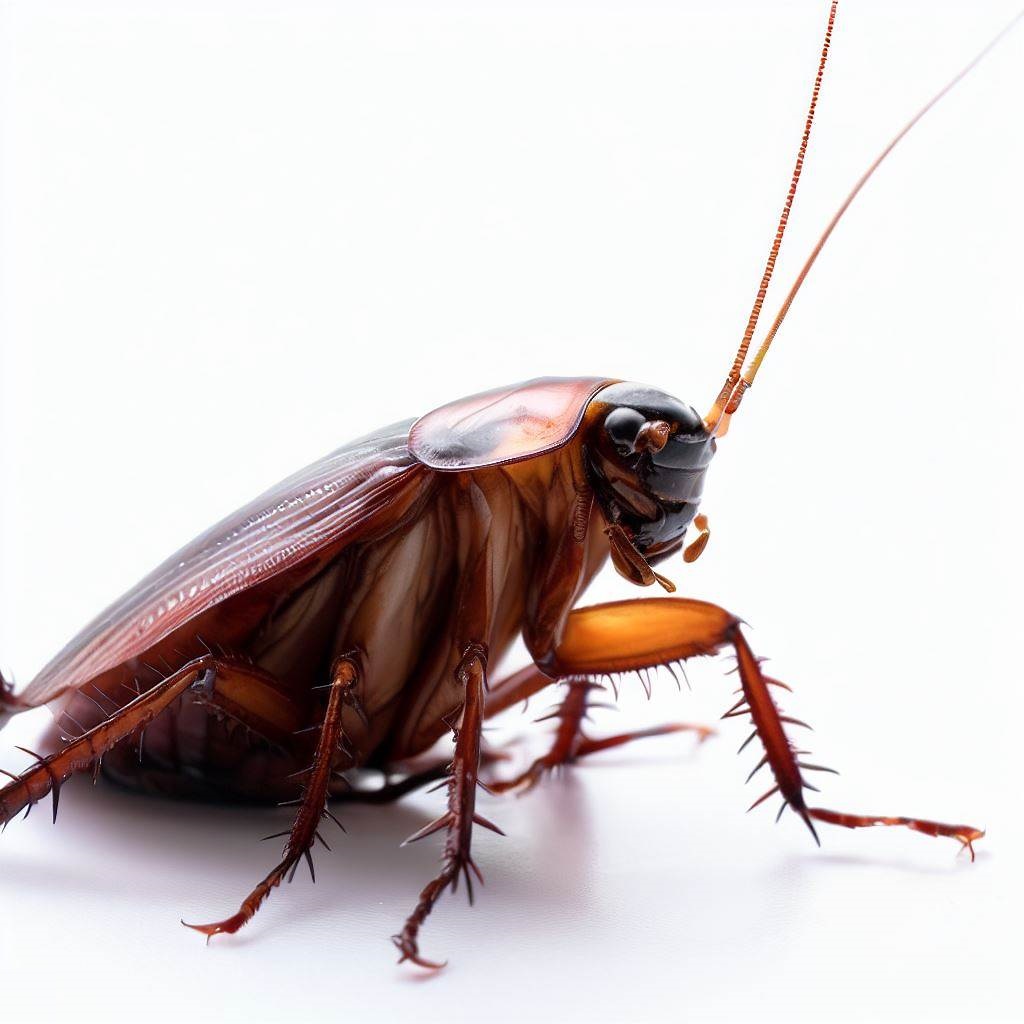Everything about Cockroaches

| Everything About COCKROACHES | |
|---|---|
| Feature | Description |
| Types | German cockroach, American cockroach, Oriental cockroach, Brown-banded cockroach, etc. |
| Size | Varies by species, from small (German cockroach) to large (American cockroach). |
| Common Habitats | Kitchens, bathrooms, basements, and anywhere with food and moisture. |
| Diet | Omnivorous scavengers; they eat almost anything, including food, paper, cloth, and dead insects. |
| Behavior | Nocturnal, known to scatter when exposed to light. They can spread various diseases. |
Dissecting Cockroaches Anatomy
Cockroaches are highly adaptable insects that belong to the order Blattodea. These insects have been around for hundreds of millions of years, and their anatomy reflects their resilience and adaptability. Here’s a dissection of their anatomy:
Head
Thorax
Abdomen
Head
- Antennae: Cockroaches have long, segmented antennae that serve as primary sensory organs. They detect touch, temperature, and chemical cues from their environment.
- Compound Eyes: These are relatively large and help the cockroach detect light and movement, aiding in its nocturnal behavior.
- Mouthparts: Cockroaches have biting and chewing mouthparts. These consist of mandibles (for biting and grinding food), maxillae (helps in handling the food), and a labium (acts as the lower lip). Together, they allow the cockroach to consume a variety of foods.
Thorax
- Legs: Cockroaches have three pairs of legs attached to the thorax. These are known for their speed and agility. The legs consist of coxae, trochanters, femora, tibiae, and tarsi. The spines on the legs help in navigation and also in defense.
- Wings: Most cockroach species have two pairs of wings attached to the thorax, though not all are adept flyers. The first pair, called tegmina, are thick and protective, while the second pair are membranous and are used for actual flight.
- Spiracles: These are small openings on the sides of the thorax and abdomen that serve as the entry and exit points for the tracheal respiratory system.
Abdomen
- Segments: The abdomen is segmented, and in males and females, the terminal segments are modified for reproductive purposes.
- Ovipositor: In female cockroaches, the ovipositor is a specialized organ used to lay eggs.
- Cerci: These are paired, segmented appendages at the end of the abdomen. They are highly sensitive and aid in detecting air currents, potentially warning the cockroach of approaching threats.
- Style: Present in some male cockroaches, these are small, finger-like projections near the cerci and are associated with reproductive structures.
- Scent Glands: Cockroaches have various glands that release pheromones for communication, especially for mating.
How Do I Get Rid of Cockroaches?
Getting rid of cockroaches requires a combination of sanitation, prevention measures, and targeted treatments.
If the cockroach infestation is minor, a DIY approach might suffice. However, for larger infestations or if previous DIY efforts have failed, it’s often more effective and efficient to hire professionals.
Choosing between a DIY approach and hiring pest control professionals for cockroach control depends on the extent of the infestation, budget considerations, and the desired results.
What are the most common types of Cockroaches
in Canada?
In Canada, while there are a few species of cockroaches, only some are commonly found infesting homes or businesses. Here are six of the most common types of cockroaches you might encounter in Canada:
- German Cockroach (Blattella germanica)
- American Cockroach (Periplaneta americana)
- Brown-Banded Cockroach (Supella longipalpa)
- Oriental Cockroach (Blatta orientalis)
- Smoky Brown Cockroach (Periplaneta fuliginosa)
- Pennsylvania Wood Cockroach (Parcoblatta pennsylvanica)

German Cockroach

American Cockroach

Brown-Banded Cockroach

Oriental Cockroach

Smoky Brown Cockroach

Pennsylvania Wood Cockroach
Schedule Your Free Cockroach Inspection
What are the characteristics of German Cockroach?

| Characteristics of German Cockroach | |
|---|---|
| Feature | Description |
| Size | Adults range from 13 to 16 mm in length. |
| Color | Light brown to tan with two dark, parallel stripes running from the head to the base of the wings. |
| Shape | Oval and flattened. |
| Lifespan | Approximately 100 to 200 days, depending on environmental conditions. |
| Reproduction | Very prolific; a female can produce 4 to 8 egg capsules in her lifetime, each containing around 30 to 48 eggs. |
What are the characteristics of Oriental Cockroach?

| Characteristics of Oriental Cockroach ) | |
|---|---|
| Feature | Description |
| Size | Approximately 1 inch in length for females and around 0.8 inches for males. |
| Color | Dark brown to black. |
| Shape | Oval and flattened, with females having wider bodies than males. |
| Habitat | Often found in damp and dark areas like basements, drains, and sewers. They are less adept climbers than other species. |
| Reproduction | Females produce an ootheca (egg case) that is initially brown and turns black in a couple of days. Each ootheca contains around 16 eggs and is often dropped or glued to a surface by the female. |
What are the characteristics of Smoky Brown Cockroach?

| Characteristics of Smoky Brown Cockroach | |
|---|---|
| Feature | Description |
| Size | Approximately 1.25 inches in length. |
| Color | Uniformly dark mahogany or shiny black-brown. |
| Shape | Oval, with a flattened body and long, slender antennae. |
| Habitat | Typically found in warm and damp environments. They are prone to dehydration, so they often seek out moisture. Commonly found in tree bark, leaf litter, woodpiles, and attics. |
| Reproduction | Females produce a dark-brown to black ootheca (egg case) that contains around 20 eggs. The ootheca is often attached to a surface in a hidden location. |
What are the characteristics of Pennsylvania Wood Cockroach?

| Characteristics of Pennsylvania Wood Cockroach | |
|---|---|
| Feature | Description |
| Size | Adult males are about 7/8 to 1 inch (22 to 25 mm) long, while females are about 1/2 to 5/8 inch (12 to 15 mm) long. |
| Color | Brown with a pale or transparent stripe on the outer edge of their thorax. |
| Shape | Oval and flattened. Males have wings that cover their body, while females have underdeveloped wings, making them unable to fly. |
| Habitat | Found outdoors, particularly in woodland areas. They prefer damp environments and are commonly found under logs, stones, and leaf litter. They sometimes wander or get carried into homes. |
| Reproduction | Females produce brown oothecae (egg cases) which they deposit in cracks or on the ground. Each ootheca contains about 30 eggs. |
What Are The Characteristics Of American Cockroach?

| Characteristics of American Cockroach | |
|---|---|
| Feature | Description |
| Size | Approximately 1.5 inches in length, making it one of the largest cockroach species. |
| Color | Reddish-brown, with a yellowish margin on the pronotum (body region behind the head). |
| Shape | Oval and flattened. |
| Lifespan | Can live up to a year under ideal conditions. |
| Reproduction | Females produce an egg capsule known as an ootheca, containing around 14 to 16 eggs. These capsules are often deposited in sheltered locations. |
What Are The Characteristics Of Brown-Banded Cockroach?

| Characteristics of Brown-Banded Cockroach | |
|---|---|
| Feature | Description |
| Size | Approximately 0.5 inches in length. |
| Color | Light brown with two pronounced dark bands running across its body. |
| Shape | Oval and flattened. |
| Habitat | Prefers warmer areas and can be found in higher locations like ceilings and upper cabinets, unlike other cockroach species that prefer the ground. |
| Reproduction | Females produce egg cases, known as oothecae, which they attach to protected surfaces. Each ootheca can contain around 10-18 eggs. |
Call us for a Free Cockroach Inspection
Top Tips To Prevent Cockroaches Infestations: Essential Guide
- Regularly inspect your home for signs of cockroach activity and address issues promptly.
- Seal cracks, crevices, and other potential entry points to prevent cockroach access.
- Ensure kitchen, bathroom, and dining areas are clean. Cockroaches are attracted to food residues, especially grease and crumbs.
- Store food items in airtight containers, ensuring no food is left exposed overnight.
- Keep garbage areas clean and ensure trash is taken out regularly.
- Fix any leaking pipes or faucets, as cockroaches are drawn to moisture.
- Consult a pest professional if a cockroach infestation becomes severe or persistent.
Frequently Asked Questions about Cockroaches
Even the cleanest homes can provide shelter, warmth, and food for cockroaches. They can be brought in with grocery bags, boxes, used appliances, or can enter from neighboring properties or the outdoors. Roaches are also attracted to moisture, so leaks or standing water can be enticing to them.
Yes, cockroaches can pose health risks to humans. They are known to carry bacteria, which can lead to food poisoning, allergies, and asthma attacks, especially in children. Their droppings, shed skins, and secretions can also aggravate allergies and asthma.
The most effective way to get rid of cockroaches is to eliminate their food, water, and shelter sources. This involves keeping a clean home, sealing off entry points, repairing any leaks, and storing food in sealed containers. Baits, traps, and pesticides can help, but in severe infestations, consulting a professional pest control service is recommended.
